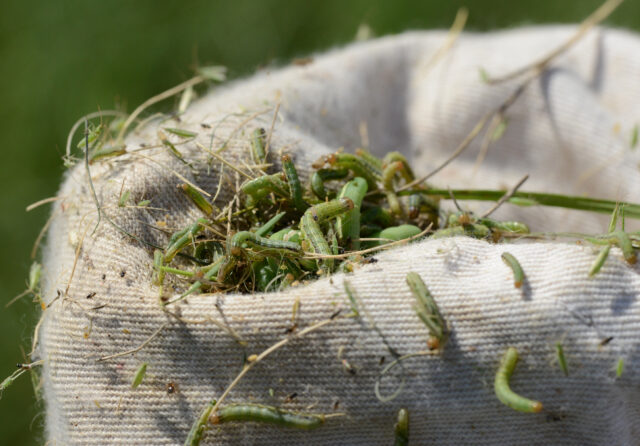by Vanessa Corriher-Olson, Ph.D.
Professor, Forage Extension Specialist
Texas A&M AgriLife Extension
Overton, TX
The fall armyworm, Spodoptera frugiperda, is a chronic pest in the Southeast. As the name indicates, fall armyworms are most numerous in late summer or early fall. Usually, reports of fall armyworm damage begin to come in during late July or early August. Occasionally, severe outbreaks occur as early as mid-May.
Fall armyworms are green, brown, or black, all having white to yellowish lines running from head to tail. A distinct white line between the eyes forms a characteristic inverted “Y” pattern on the face. Four black spots form a square near the back. At first, armyworms are tiny (1/8 inch) and often go unnoticed because they cause little plant damage. The larvae feed for 2 to 3 weeks; when full grown, they are about 1 to 1 ½ inches long. Given their immense appetite, great numbers, and marching ability, fall armyworms can damage entire fields or pastures in 2 or 3 days.
Once the armyworm larva completes feeding, it tunnels about an inch into the soil and enters the pupal stage. The moth emerges from the pupa in about 10 days and repeats the life cycle. Development of all stages of the fall armyworm is driven by temperature, so as temperatures cool in autumn it will take longer for the caterpillars to develop. Caterpillars can develop whenever the temperature is above 55 degrees F. The fall armyworm moth has a wingspan of about 1½ inches. The front pair of wings is dark gray with an irregular pattern of light and dark areas. The moths are active at night when they feed on nectar and deposit egg masses. A single female can deposit up to 2,000 eggs. There are four or more generations of fall armyworm each year. Each generation takes about 30 days under Texas summer conditions.
Fall armyworms are typically most active early in the morning, late in the afternoon, or in early evening, but on taller, unmowed grass, they can be observed feeding on forage throughout the day. On closely grazed or recently mowed hayfields, fall armyworm larvae spend the warmer hours of the day deep in the sod.
Fall armyworm damage often seems to appear overnight. Young armyworms don’t eat much. Almost all of the damage is caused by the oldest caterpillars, which in four days of feeding, eat more than all the other ages put together. Therefore, an infestation may have been present but not detected because of the small size of the caterpillars.
The key to keeping these pests below the economic threshold is scouting at least every other day for worms, when they are small and easier to control. Fields damaged by fall armyworm should be closely monitored for the rest of the season to determine whether further treatment is required. If left untreated, armyworms can destroy a newly established winter pasture in a very short time.
It is critical to identify and if necessary, treat armyworms by their fourth larval stage. Armyworms will consume approximately 75-80% of their total dry matter intake during the final two larval stages. Additionally, once they become greater than ½ inch long, they become more difficult to control with insecticides.
Scounting pastures and hayfields can help detect fall armyworm infestations before they cause economic damage. Scout along field borders as well as uniformly across the field. Armyworms will often move into fields from weeds along the field edges and fencerows. Treatment can sometimes be limited to the field margins, saving considerable chemical cost.The best way to detect fall armyworms is to use an insect net to sweep the forage grass. A sweep net picks up larvae that are too small to find in any other way. Sweep the grass in early morning of late afternoon to check for the presence of young armyworms. Damage will start as feeding on the epidermal layers of the leaves, causing a windowpane effect, and progress to chewing through entire leaves. Look on the plants for actively feeding caterpillars, but also look underneath dirt clods and forage litter for caterpillars that are hiding to escape daytime temperatures. They are usually easier to find in the early morning hours or at dusk. You can also watch for birds foraging in a concentrated area of a field and scout that area to see if they are feeding on armyworms.
The economic threshold for control varies depending on the cost of chemical treatment and the value of the crop, but in general two to four worms per square foot in improved pasture (i.e., bermudagrass) is a good starting place. Seedlings can tolerate fewer armyworms than can older plants. In bermudagrass hay, consider using an insecticide if there are more than 2-3 armyworms ½ inch or longer per square foot.
There are a wide variety of insecticide options for control of armyworms. Which to choose depends on the crop grown, the armyworm species present, their size or growth stage, proximity to sensitive crops or neighborhoods, etc. Always refer to the specific insecticide label to ensure it is labeled for your crop and in your state, for the correct rate to control the species present and for any grazing, harvest, or retreatment restrictions. Remember, the label is the law.
The key to managing armyworms is to inspect the fields often to detect infestations before they cause economic damage. Fall armyworm outbreaks in pastures and hayfields often occur after rain, which apparently creates favorable conditions that allow many eggs and small larvae to survive. Especially susceptible to fall armyworm infestations are recently fertilized and irrigated fields that have a dense canopy and vigorous growth.
Also monitor weedy grasses in ditches and around fields, which may be a source of armyworms that can move into the nearby crop. Look for the larvae feeding on the grass in late evening and early morning and during cool, cloudy weather. Fall armyworms can be found up until the first killing frost in the area. However, the risk of damage declines as it gets cooler because the pest develops more slowly in cooler temperatures.
For additional information about fall armyworms and their control, reach out to your local County Extension Agent, IPM Agent, or Extension Entomologist.












